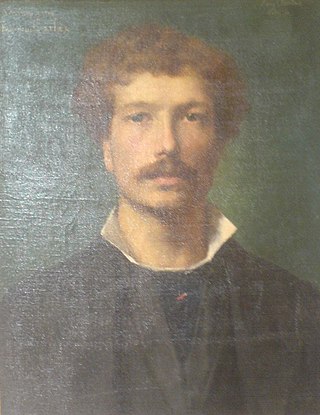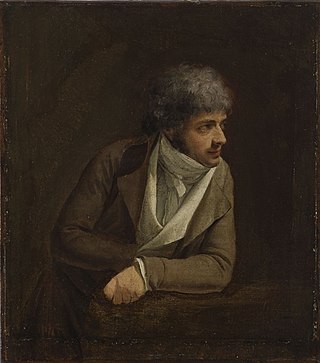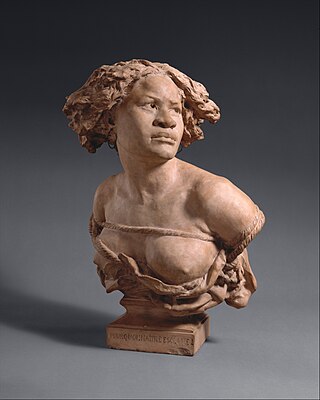
Jean-Baptiste Carpeaux was a French sculptor and painter during the Second Empire under Napoleon III.

Antoine Étex was a French sculptor, painter and architect.

Baron François Joseph Bosio was a Monegasque sculptor who achieved distinction in the first quarter of the nineteenth century with his work for Napoleon and for the restored French monarchy.

Louis-Pierre Deseine (1749–1822) was a French sculptor, who was born and died in Paris. He is known above all for his portrait busts and imaginary portraits.

Charles-François Lebœuf, called Nanteuil was a French sculptor.

Jean-Baptiste Auguste Clésinger was a 19th-century French sculptor and painter.

Jean-Antonin Carles was a French sculptor.

Émile Nestor Joseph Carlier, called Joseph Carlier, was a French sculptor.

Groupe de femmes, also called Groupe de trois femmes, or Groupe de trois personnages, is an early Cubist sculpture created circa 1911 by the Hungarian avant-garde, sculptor, and graphic artist Joseph Csaky (1888–1971). This sculpture formerly known from a black and white photograph had been erroneously entitled Deux Femmes , as the image captured on an angle showed only two figures. An additional photograph found in the Csaky family archives shows a frontal view of the work, revealing three figures rather than two. Csaky's sculpture was exhibited at the 1912 Salon d'Automne, and the 1913 Salon des Indépendants, Paris. A photograph taken of Salle XI in sitiu at the 1912 Salon d'Automne and published in L'Illustration, 12 October 1912, p. 47, shows Groupe de femmes exhibited alongside the works of Jean Metzinger, František Kupka, Francis Picabia, Amedeo Modigliani and Henri Le Fauconnier.

Charles-Louis Corbet was a French sculptor. He is known for a bust that he made of Napoleon and a statue of a French Dragoon on the Arc de Triomphe du Carrousel.

André-César Vermare was a French sculptor, known for his war memorials and monuments.

Onésime-Aristide Croisy was a French sculptor. He is known for his dramatic bronze military statues, but perhaps best known for his marble Le Nid, showing two children asleep in an armchair.

Eilhard Mitscherlich is a sculpture of German chemist Eilhard Mitscherlich by sculptor Elisabet Ney. Completed in 1863, the piece is a portrait bust rendered in marble. The marble bust is now held by the Berlin's Natural History Museum, while the original plaster is displayed in Mitscherlich's mausoleum in Berlin's Alter St.-Matthäus-Kirchhof.

Eve is a nude sculpture by the French artist Auguste Rodin. It shows Eve despairing after the Fall.

Cain and His Race Cursed By God is an 1833-1839 marble sculpture by Antoine Étex. It was produced after an initial version in plaster which was made in Rome between 1831 and 1832, now in the Saint-Louis Chapel at the Pitié-Salpêtrière Hospital. It was inspired by the Biblical story of Cain's murder of Abel. It was firsts exhibited as a plaster version at the Paris Salon of 1833, where it proved very successful and put him at the forefront of the 1830s generation of Romantic sculptors. The marble version was finished in 1839 and is now in the Museum of Fine Arts of Lyon.

Sakuntala, also known as Sakountala or Çacountala, is a sculpture by the French artist Camille Claudel, made in several versions in different media from 1886, with a marble version completed in 1905, and bronze castings made from 1905. The sculpture depicts a young couple, with a kneeling man embracing a woman leaning towards him. It was named after the play Shakuntala by the 4th-5th century Indian poet Kālidāsa, and is inspired by the moment when the title character Shakuntala is reunited with her husband Dushyanta after a long separation.

Why Born Enslaved? or Why Born a Slave? is a life-sized bust by the French sculptor Jean-Baptiste Carpeaux depicting a bound woman of African descent. Carpeaux executed versions of the sculpture in plaster, marble, terracotta, and bronze. It is represented in a number of museums, including the Ny Carlsberg Glyptotek in Copenhagen and the Metropolitan Museum of Art in New York City.

The Prodigal Son is a sculpture group by George Grey Barnard that depicts the loving reunion of the father and son from the New Testament "Parable of the Prodigal Son."
This page is based on this
Wikipedia article Text is available under the
CC BY-SA 4.0 license; additional terms may apply.
Images, videos and audio are available under their respective licenses.


















